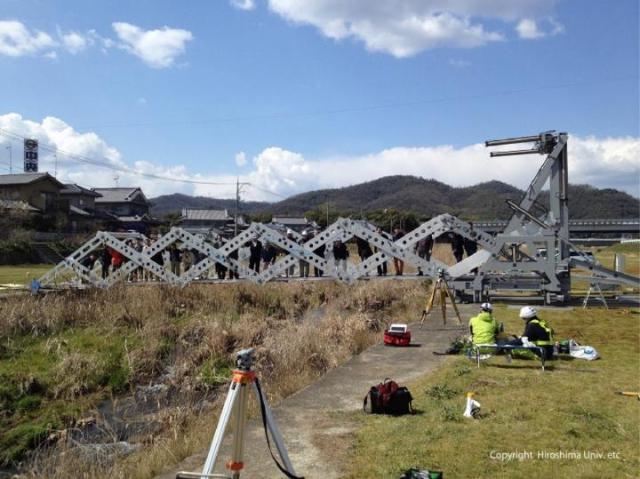Jul 24 2015
A test of the Mobile Bridge® Version 4.0 (MB4.0) over a real river demonstrated its viability for practical use. During the test, the bridge was set up without any foundation work, and a vehicle could easily travel across it. This was achieved safely with very few people and without any problems. The MB4.0 viability test results were presented at a symposium of the Japan Society of Civil Engineers (JSCE) on June 23, 2015, by Dr. Ichiro Ario, Assistant Professor at the Institute of Engineering, Hiroshima University.
 People walked on the completed MB over the Hongo river in Fukuyama City at its first construction test. Credit: Hiroshima University, Japan Construction Method and Machinery Research Institute, Hoshikei-kinzoku Industry Co.,Ltd., Akashin Co.,Ltd., Sankyo Tateyama, Inc., and Yokoyama Kisokouji Co.,Ltd.
People walked on the completed MB over the Hongo river in Fukuyama City at its first construction test. Credit: Hiroshima University, Japan Construction Method and Machinery Research Institute, Hoshikei-kinzoku Industry Co.,Ltd., Akashin Co.,Ltd., Sankyo Tateyama, Inc., and Yokoyama Kisokouji Co.,Ltd.
Background of developing MB:
Natural disasters include earthquakes, floods, tsunamis, and landslides. They can occur anywhere in the world. The damage caused by such disasters to infrastructure such as bridges necessitates a rapid response to rescue survivors and deliver medical care to the injured within a new set of localized constraints.
- New secondary hazards caused by localized damage can impede any rescue operations.
- This raises the question of what useful activities can be performed in the immediate aftermath of a major natural disaster.
- In many disasters, urgent medical attention can be delivered to injured survivors only if a new bridge is constructed or deployed rapidly.
- In certain situations, an emergency bridge may be needed even where no professional structural engineers are available.
We propose a new type of foldable/deployable bridge with a scissor mechanism called Mobile Bridge (MB). MB4 can be deployed and folded quickly, and it therefore provides highly efficient construction and easy transportation.
In the aftermath of a natural disaster, rapid repair of infrastructure is required. A fast response will significantly improve disaster recovery efforts. Dr. Ario of Hiroshima University proposed a new concept in bridge innovation.
- Rapid response will help provide urgent medical aid to injured survivors.
- Any rescue technology should have a low level of complexity and high degree of resilience to enable its deployment by any persons in a locality.
- MB uses a patented technology with a scissor mechanism for deploying an emergency bridge system set within a modular design.
- MB is a compact transportable bridge system; it is suitable for transportation using a car trailer, and it can be easily deployed and folded using its scissor mechanism.
- This bridge system has a completely novel design and offers extraordinary performance that cannot be matched by the older block assembly approach for bridges.
MB can be deployed in a wide range of areas and has numerous applications. Many existing bridges are in a poor state of repair owing to poor maintenance and overuse. Smaller bridges can be kept operational using MB. This affords the advantage of keeping bridges fully operational without interrupting traffic and causing further damage to the existing bridge by traffic.
Background of development based on Origami:
MB has a scissor-like structure that is connected to the main structural members to form an "X" shape; this enables expansion and contraction while retaining strength. The idea for this new bridge comes from academic studies on buckling based on Origami (Japanese traditional paper craft), which has attracted the attention of researchers in space development and other fields.
Dr. Ario developed MB4.0 as a type of robotic bridge by improving its mobility and functionality and decreasing its weight. Therefore, MB4.0 has become more transportable and easier to set up at temporary construction places without any foundation construction or crane operations. As a result, it is also less costly.
MB4.0 is the world's fastest, largest, strongest, and lightest expanding temporary bridge. In addition, it is the fastest to set up. Because the bridge and its lanes are expanded simultaneously, the bridge is ready for traffic as soon as it is fully expanded. From the arrival of MB4.0 on site to its full expansion only takes around one hour. The actual extension time is only around five minutes. This is especially important for time-sensitive situations during a disaster.
Dr. Ario stated that "From this test of a new bridge concept, the next generation of bridge technology starts on a new stage in the field of bridge engineering. It is possible to use a real deployable and smart bridge with a scissor-type bridge system using this structural theory. I will further promote the development and evolution of MB4.0 in the future. Making MB stronger, longer, lighter, more compact, and quicker to set up will promote the development of infrastructure construction technology in general."